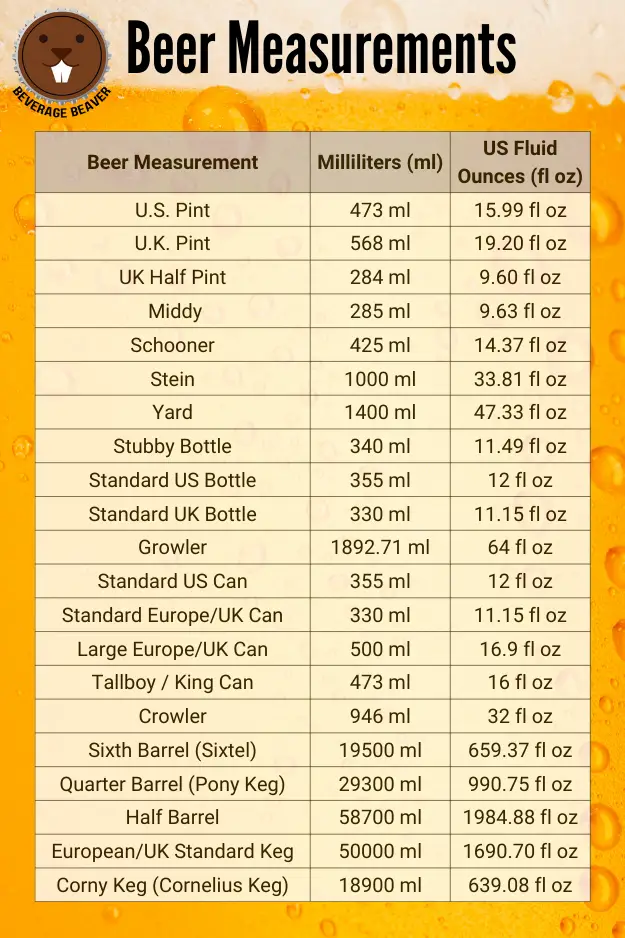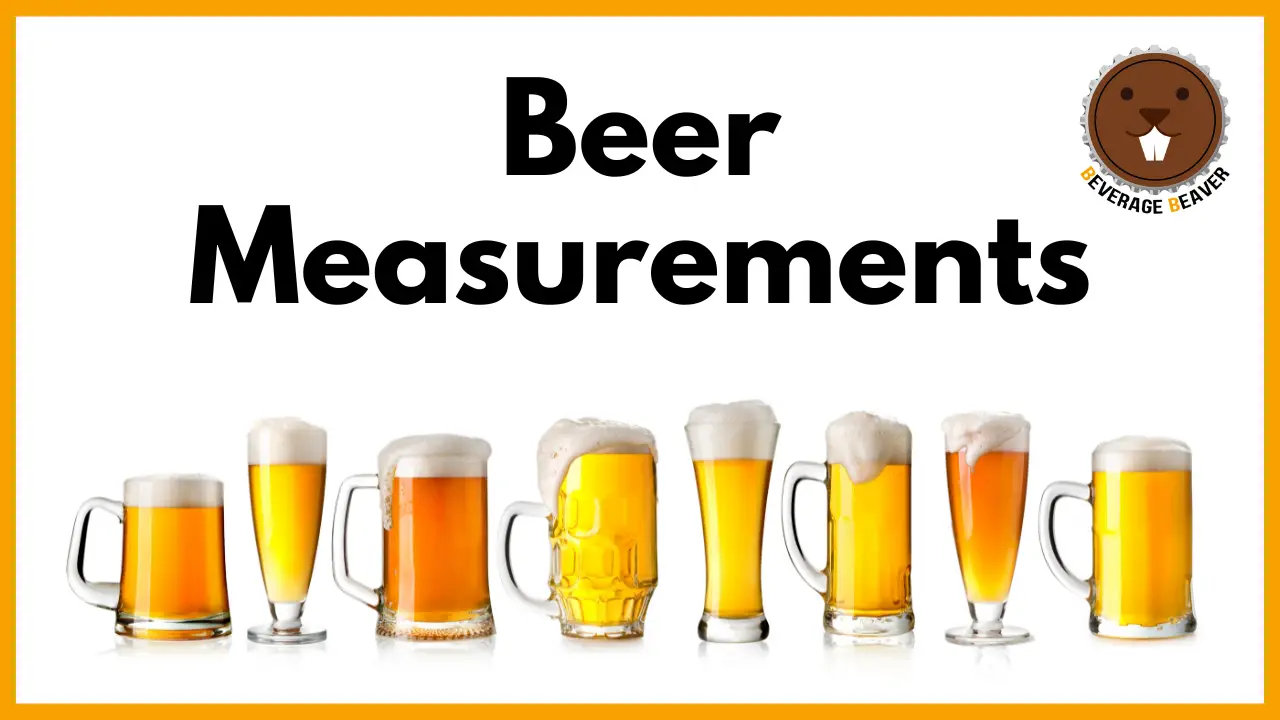From Pints to Ounces: A Global Guide to Beer Measurements
Ever paused at a bar in London, eagerly waiting for a pint, only to realize it seems more generous than your regular pint back in New York? Or ever scratched your head over why that 330ml beer can in Paris didn’t quite match up to the 12oz you’re accustomed to in the States? Well, it’s not just the beer itself that varies from region to region — it’s the measurements, too.
From the hearty UK pint to the precise fluid ounces in the US, the journey of beer measurements is vast and varied. In this guide, we will show you how beer measurements differ around the world and provide you with an extensive list of common beer measurements. We’ll also answer some frequently asked questions about beer measurements and sizes. So, the next time you’re clinking glasses in Munich or raising a toast in Tokyo, you’ll know exactly what’s in your hand.
Beer Measurements Compared
Before we delve into why beer measurements vary across the world, for your reference, here’s a table that compares the different beer measurements and packaging sizes in milliliters (ml) Fluid Ounces (fl oz) and Imperial Fluid Ounces.
| Beer Measurement | Milliliters (ml) | US Fluid Ounces (fl oz) | Imperial Fluid Ounces (fl oz) |
|---|---|---|---|
| U.S. Pint | 473 ml | 15.99 fl oz | 16.64 fl oz |
| U.K. Pint | 568 ml | 19.20 fl oz | 20 fl oz |
| UK Half Pint | 284 ml | 9.60 fl oz | 10 fl oz |
| Middy | 285 ml | 9.63 fl oz | 10 fl oz |
| Schooner | 425 ml | 14.37 fl oz | 15 fl oz |
| Stein | 1000 ml | 33.81 fl oz | 35.19 fl oz |
| Yard | 1400 ml | 47.33 fl oz | 49.27 fl oz |
| Stubby Bottle | 340 ml | 11.49 fl oz | 11.96 fl oz |
| Standard US Bottle | 355 ml | 12 fl oz | 12.49 fl oz |
| Standard Europe Bottle | 330 ml | 11.15 fl oz | 11.61 fl oz |
| Standard UK Bottle | 330 ml | 11.15 fl oz | 11.61 fl oz |
| Growler | 1892.71 ml | 64 fl oz | 66.61 fl oz |
| Magnum | 1500 ml | 50.72 fl oz | 52.79 fl oz |
| Standard US Can | 355 ml | 12 fl oz | 12.49 fl oz |
| Standard Europe/UK Can | 330 ml | 11.15 fl oz | 11.61 fl oz |
| Large Europe/UK Can | 500 ml | 16.9 fl oz | 17.59 fl oz |
| 440ml Can | 440 ml | 14.87 fl oz | 15.48 fl oz |
| Tallboy / King Can | 473 ml | 16 fl oz | 16.64 fl oz |
| Crowler | 946 ml | 32 fl oz | 33.29 fl oz |
| Sixth Barrel (Sixtel) | 19500 ml | 659.37 fl oz | 686.30 fl oz |
| Quarter Barrel (Pony Keg) | 29300 ml | 990.75 fl oz | 1031.21 fl oz |
| Half Barrel | 58700 ml | 1984.88 fl oz | 2065.95 fl oz |
| European/UK Standard Keg | 50000 ml | 1690.70 fl oz | 1759.75 fl oz |
| Corny Keg (Cornelius Keg) | 18900 ml | 639.08 fl oz | 665.18 fl oz |
Common Beer Measurements
U.S. Pint
The U.S. Pint (often referred to as the “liquid pint”) is primarily used in the United States. A typical U.S. Pint is 473 ml, which is approximately 16 fl oz. This is smaller than the UK Pint, which measures 568 ml, approximately 19.20 fl oz.
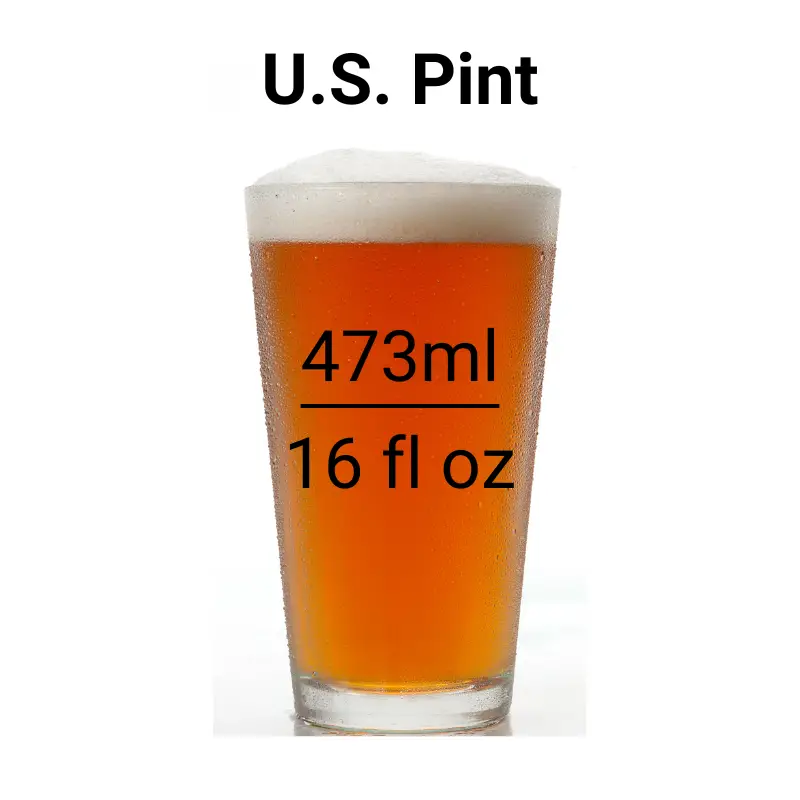
U.K. Pint
The U.K. Pint is an ‘Imperial Pint’ which is the equivalent to 20 imperial fluid ounces. This is the standard serving size for draft beer in the U.K. and measures 568ml, which is approximately 19.20 fl oz.
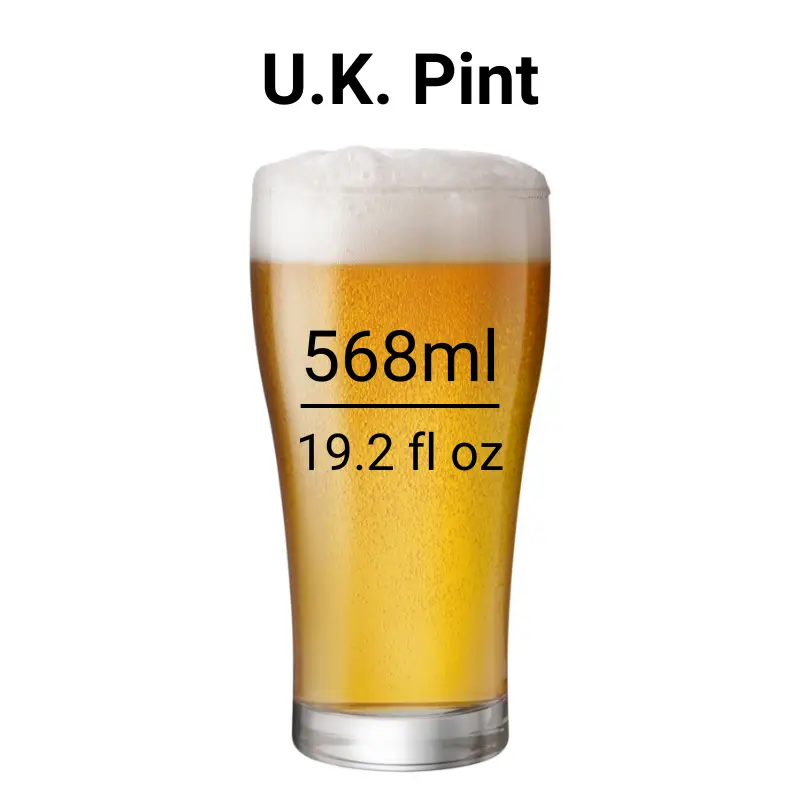
U.K. Half Pint
The U.K. Half Pint is half the size of an ‘Imperial Pint’. It is equivalent to 10 imperial fluid ounces. This is a standard serving size for certain beverages in the U.K. and measures 284ml, which is approximately 9.60 fl oz.

Middy
The ‘middy’ is an Australian beer glass size, measuring 285ml, which is approximately 9.63 fl oz. It’s a popular serving size in some states. The name and exact volume can vary by region, with similar sizes referred to differently in various parts of Australia.
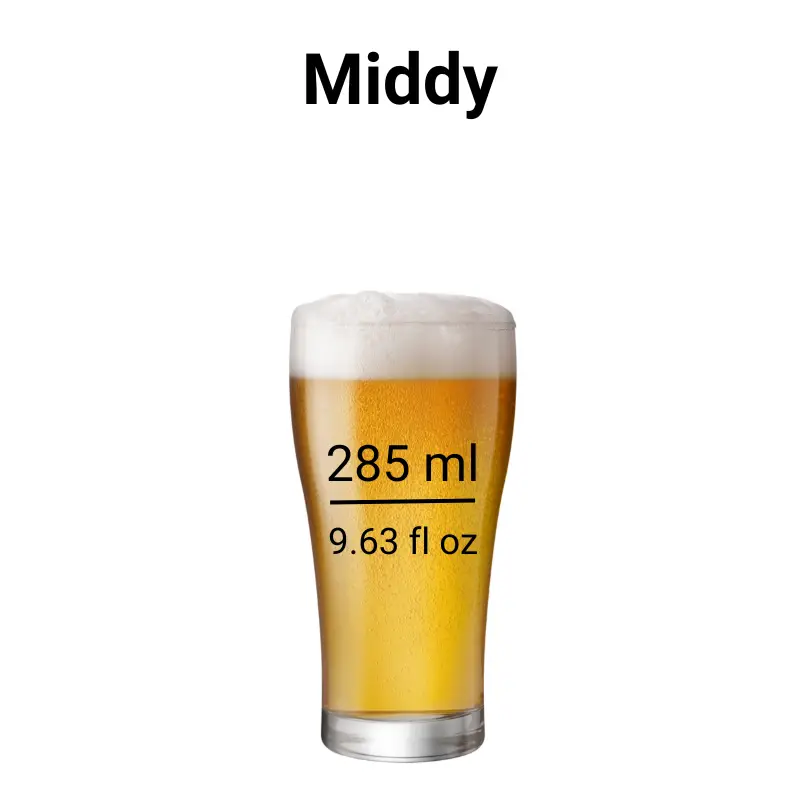
Schooner
The ‘schooner’ is an Australian beer glass size, measuring 425ml, which is approximately 14.40 fl oz. It’s a common serving size in many parts of the country, although the name and exact volume might vary by region.

Stein
The ‘stein’ is a traditional German beer mug, often associated with festivals like Oktoberfest. Its capacity can vary, but common sizes measure around 500ml to 1 liter, which is approximately 16.90 fl oz to 33.81 fl oz. The stein is known for its sturdy design, often made of stoneware and sometimes adorned with intricate designs or metal lids.
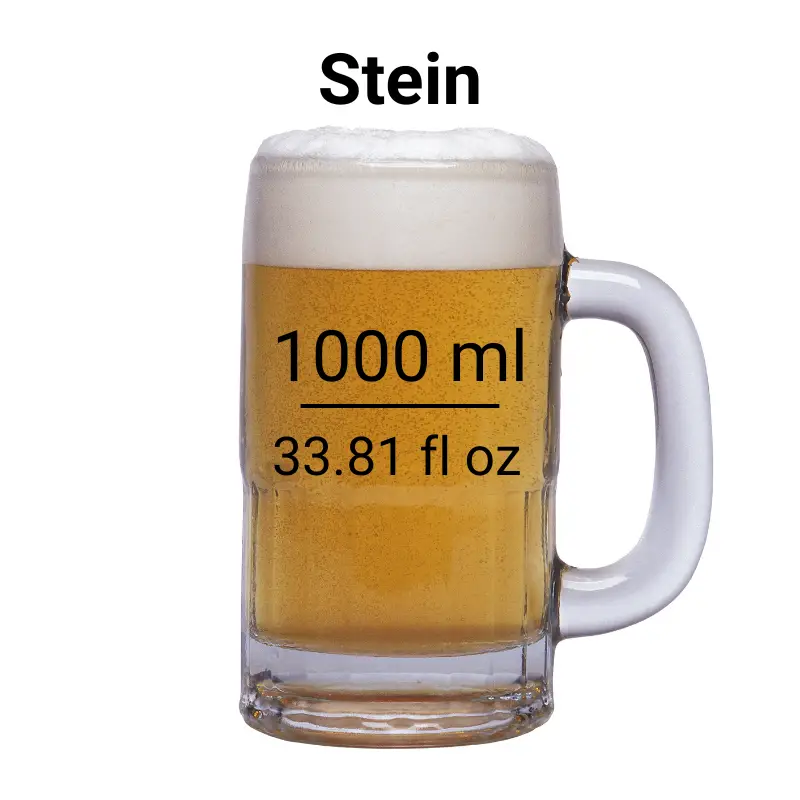
Yard Of Beer
The ‘yard of beer’ is a tall and slender glass that measures approximately 3 feet in length. Its capacity is typically around 1.4 liters, which is approximately 47.34 fl oz. Historically, it was used in England for festive or ceremonial drinking, and today, it’s often associated with drinking challenges in pubs or as a novelty item in some establishments.
Stubby Bottle
The ‘stubby bottle’ is a short and stout beer bottle, commonly associated with Canadian and Australian beer packaging. It typically holds 375ml, which is approximately 12.68 fl oz. Its compact design differs from the longneck bottles often seen in other regions, and it has a nostalgic charm for many who remember its widespread use in decades past.

Standard US Bottle
The ‘standard US bottle’ for beer is a longneck bottle often referred to as a ‘regular’ or ‘industry standard’ bottle. It typically holds 12 fl oz, which is approximately 355ml. This is one of the most common sizes for bottled beer in the United States and is recognized by its slender neck and body.
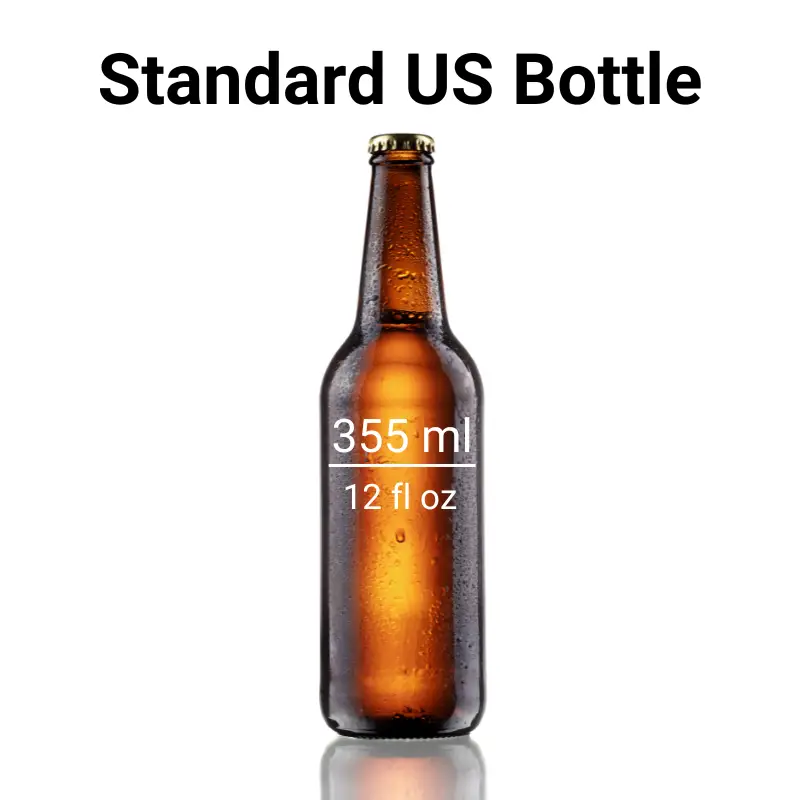
Standard Europe/UK Bottle
The ‘standard European/UK bottle’ for beer is commonly associated with the traditional design prevalent in many European countries. It typically holds 330ml, which is approximately 11.16 fl oz. This size is one of the most frequent for bottled beer in Europe, though variations exist depending on the country and specific brewery traditions.
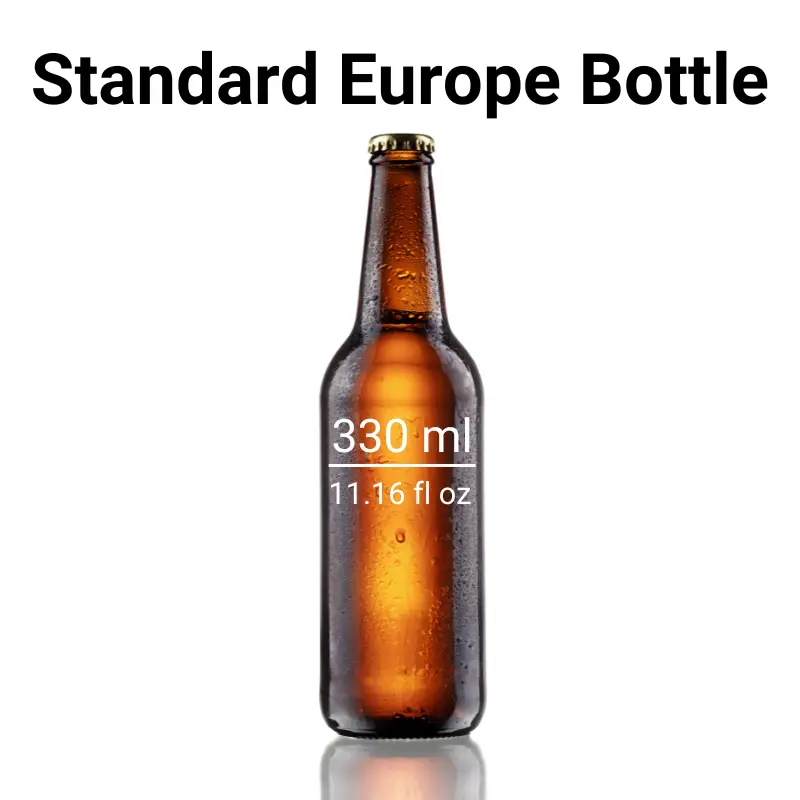
Growler
The ‘growler’ is a container used for the transport and takeout of draft beer. Traditionally made of glass, but also available in ceramic, stainless steel, and plastic, it’s popular in many craft beer communities around the world. The most common size for a growler is 64 fl oz, which is approximately 1.89 liters. However, variations like the ‘half-growler’ or ‘howler’ exist, typically holding 32 fl oz or about 946ml.

Magnum
The ‘magnum’ is a large bottle size primarily used for champagne and wine, though it can occasionally be used for specialty beers as well. A magnum typically holds 1.5 liters, which is approximately 50.72 fl oz. This size is equivalent to two standard wine bottles and is often chosen for festive occasions or celebrations due to its impressive size and presence.
Standard US Can
The ‘standard US can’ for beer and soft drinks is a widely recognized format throughout the United States. It typically holds 12 fl oz, which is approximately 355ml. This size is one of the most common for canned beverages in the US and is the go-to choice for many major breweries and soda manufacturers.
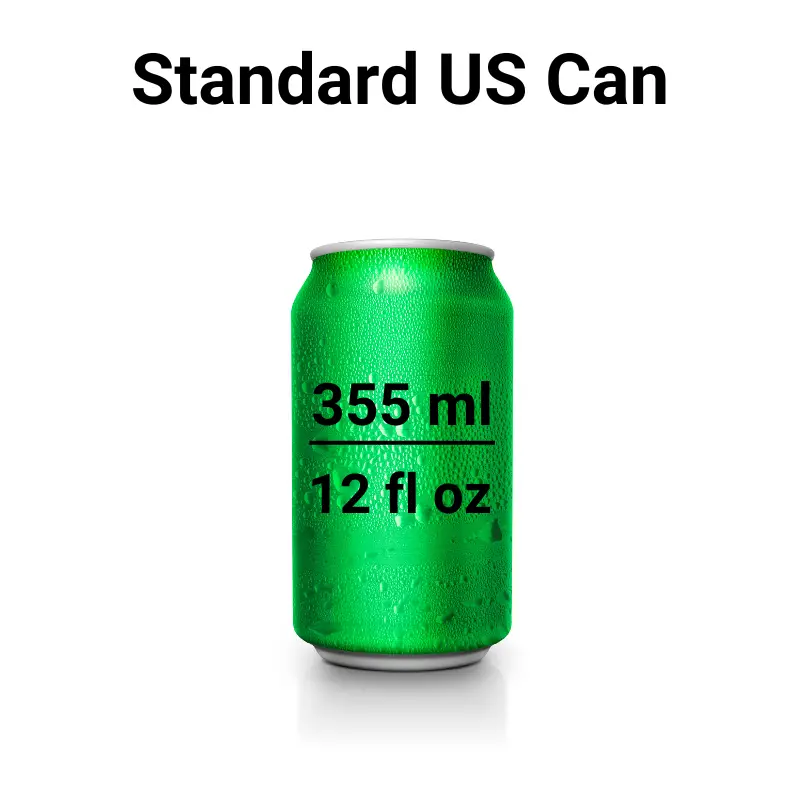
Standard Europe/UK Can
The ‘standard Europe/UK can’ for beer and soft drinks is a prevalent format across many European countries and the UK. It typically holds 330ml, which is approximately 11.16 fl oz. This size is a standard choice for many breweries and beverage companies throughout the region, aligning closely with the typical European bottled beer size.
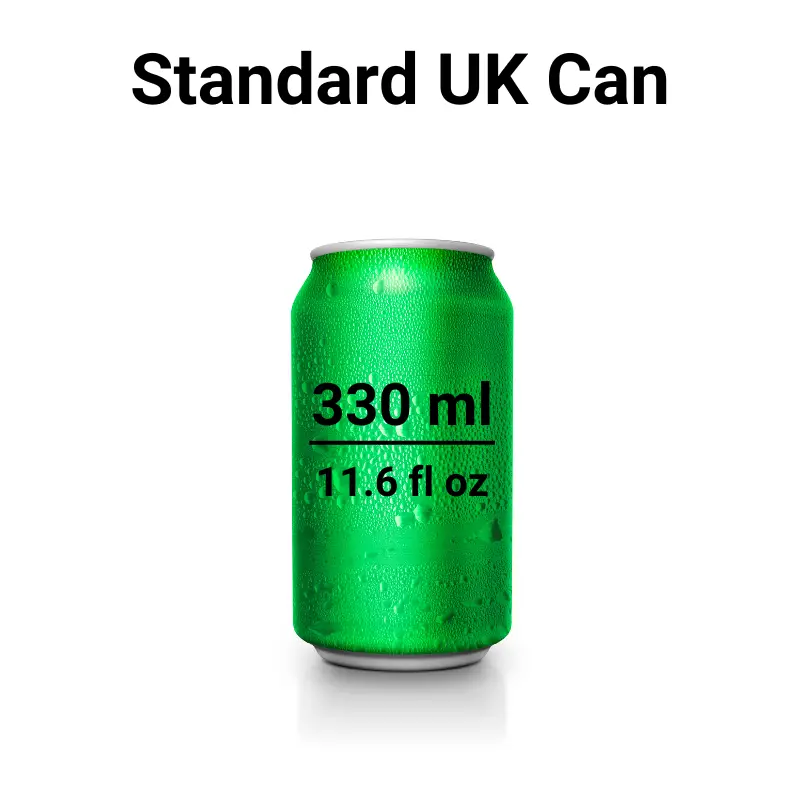
Large Europe/UK Can
The ‘large Europe/UK can’ for beer and other beverages is a common format found in many European countries and the UK. It typically holds 500ml, which is approximately 16.90 fl oz. This size is particularly popular for beers, ciders, and certain soft drinks, offering a more generous serving than the standard 330ml can.
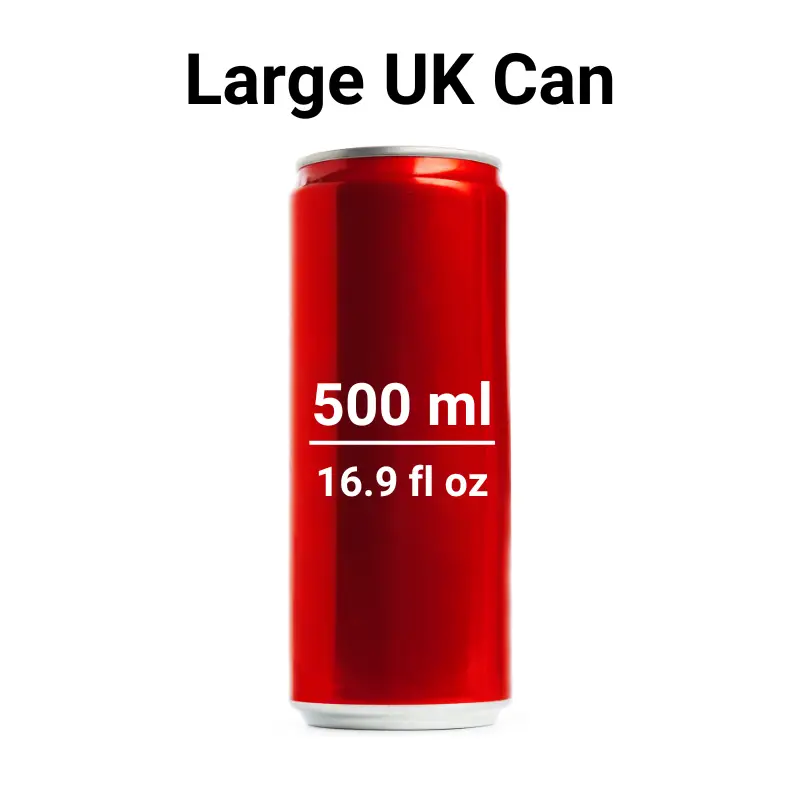
440ml Can
The 440ml can is a format that’s commonly associated with the UK, where it’s often found as a packaging choice for beers and ciders. In fluid ounces, it measures approximately 14.88 fl oz. While the 440ml size is typical in the UK, it is also available in other countries such as South Africa, New Zealand, and Australia.
Tallboy / King Can
The ‘tallboy’ or ‘king can’ is a larger-sized can format commonly found in North America and various other parts of the world. It typically holds 16 fl oz in the U.S., which is approximately 473ml, though the term can sometimes be used to describe cans up to 24 fl oz (710ml) in certain contexts.
Crowler
The ‘crowler’ is a recent addition to the beer packaging world, originating from the craft beer movement in the U.S. A crowler is essentially a large, sealable beer can that’s filled and sealed on-site at breweries or taprooms. It typically holds 32 fl oz, which is approximately 946ml.
The crowler is designed to offer a fresh-from-the-tap experience for consumers to take home. Made of aluminum, it’s seen as an alternative to the traditional glass growler, providing a lightproof and airtight container that can keep beer fresher for longer.
Sixth Barrel (Sixtel)
The ‘Sixth Barrel’ or ‘Sixtel’ is a keg size primarily used in the beer industry. It holds 5.16 US gallons, which is approximately 19.5 liters or 661.44 fl oz. The Sixth Barrel is popular among craft brewers and establishments that wish to rotate taps frequently, as its size offers a manageable volume that allows for quick turnover and variety.
It’s roughly equivalent to having 56 12-oz servings of beer. Compact and easier to handle than larger keg types, the Sixtel is a favored choice for limited releases, seasonal beers, or venues with limited storage space.
Quarter Barrel (Pony Keg)
The ‘Quarter Barrel’, commonly referred to as the ‘Pony Keg’, is a keg size often utilized in the beer industry. It holds 7.75 US gallons, which equates to approximately 29.3 liters or 992 fl oz. The Quarter Barrel is half the size of the standard beer keg, which is the Half Barrel or 15.5 US gallons.
Due to its compact size, the Pony Keg is a popular choice for parties, events, or locations with limited space. It’s roughly equivalent to having 82 12-oz servings of beer. The manageable volume of the Pony Keg allows venues to offer a variety of beer options without the commitment of a larger keg.
Half Barrel
The ‘Half Barrel’ is the standard keg size predominantly used in the beer industry, especially in the United States. It holds 15.5 US gallons, which translates to approximately 58.7 liters or 1,984 fl oz. Often simply referred to as a ‘keg’ in casual contexts, the Half Barrel is the benchmark for keg sizes, with other sizes typically defined in relation to it.
It provides around 165 12-oz servings of beer. Due to its volume, the Half Barrel is a staple for bars, restaurants, and large events where a significant amount of beer is expected to be consumed.
European/UK Standard Keg
The European/UK Standard Keg, often referred to as a ’50-liter keg,’ is commonly used in Europe and the UK for beer distribution. It holds 50 liters, which equates to approximately 13.2 US gallons or 1,760 fl oz.
This keg size is slightly smaller than the U.S. Half Barrel but is a standard for many breweries and establishments throughout Europe and the UK. It provides roughly 140 12-oz servings or about 88 pints (using the UK’s 20 fl oz pint measurement). The European/UK Standard Keg is a principal choice for many bars, pubs, and events across the continent.
Corny Keg (Cornelius Keg)
The ‘Corny Keg’ or ‘Cornelius Keg’ is a smaller keg format that originally was used by the soft drink industry for dispensing sodas. However, it has since been adopted by the homebrewing community due to its manageable size and ease of use. A standard Corny Keg holds 5 US gallons, which is approximately 18.9 liters or 640 fl oz.
The keg features a simple design with snap-on connectors for both the gas in and beverage out, making it a convenient choice for homebrewers. There are two primary types of Corny Kegs, differentiated by their connector types: pin-lock and ball-lock. While Corny Kegs are less common in commercial settings today, they remain popular among those brewing beer at home.
Why Beer Measurements Are Different Around The World
When you travel the world, one of the many cultural nuances you’ll discover is the way beer is poured and measured. Order a beer in London, Tokyo, Sydney, or New York, and you’re likely to receive it in a different quantity and potentially even a unique container. So, why are beer measurements not standardized globally? The answer lies at the crossroads of history, culture, and economics.
The way beer is measured often dates back to historical traditions. For example, in the UK, the pint has been a standard measurement for centuries and is deeply entrenched in British drinking culture. The origin of the pint itself can be traced back to the medieval period when it was defined as 1/8 of a gallon.
In some places, the preference is for smaller, more frequent drinks, while in others, larger quantities are favored. For instance, in Belgium, beer is often served in smaller glasses to accentuate the flavors of their richly varied brews. On the other hand, in Germany, especially during Oktoberfest, you might find yourself holding a one-liter stein of beer.
Taxation and legal regulations can also play a role in why beer measurements are different. In countries or regions where alcohol is taxed heavily by volume, it might make more economic sense for establishments to serve beer in smaller quantities. Some countries also have regulations on the maximum or minimum amount of alcohol that can be served at one time. This can influence how much beer is poured per serving.
The diversity in beer measurements is a reflection of the rich tapestry of global beer-drinking cultures. It underscores the fact that beer, much like food, music, and language, is deeply intertwined with a region’s history and traditions.
Beer Measurements FAQ
What’s The Difference Between A UK Pint And A US Pint?
A UK pint holds 568.261 milliliters, commonly rounded to 568 ml, while a US pint contains 473.176 milliliters, often rounded to 473 ml. This means that when you order a pint in the UK, you’re getting about 95 ml more than in the US.
Why Are UK Pints And US Pints Different?
The difference between UK pints and US pints stems from their respective historical measurement systems. The UK pint is part of the Imperial system, which has its origins in traditional British units of measurement. Over time, these units were standardized into what is known as the Imperial system, used in Britain and its colonies.
The US pint, on the other hand, is part of the US customary system. While it has some roots in the British system, it evolved separately after the American Revolution, leading to variations in measurements. As a result, the two nations, despite sharing some unit names, ended up with differing volumes for their “pint.”
How Is Beer Measured In The USA?
In the USA, beer is primarily measured using the fluid ounce (oz) as a unit of volume. Common sizes of beer sold include:
12 oz: The standard serving size for a can or bottle of beer.
16 oz: Often referred to as a “pint” in many bars and restaurants, although it’s 2 ounces short of the true British pint. This size is typical for draft beer.
22 oz: Known as a “bomber” bottle, it’s a popular size for craft and specialty beers.
32 oz: Sometimes called a “quart” or “growler,” it’s a less common size but can be found in some breweries and taprooms.
64 oz: Commonly known as a “growler,” it’s a jug used to carry draft beer from breweries or taprooms.
128 oz: Also known as a “keg,” it’s the standard for commercial beer kegs.
How Is Beer Measured In The UK?
In the UK, beer is predominantly measured using the pint as a unit of volume. Here are some standard measurements:
1/2 Pint (284 mL): Half of the standard serving size, often ordered for lighter consumption.
Pint (568 mL): The standard serving size for a draft beer in pubs and bars. When someone refers to ordering a beer in the UK, they typically mean a pint.
330 mL: A common size for bottled beers, especially those from international brands or craft breweries.
440 mL: Another prevalent can size, often seen for lagers and ales sold in supermarkets.
500 mL: A typical size for bottled ales and specialty beers.
How Many ml In A Standard 12 oz Beer?
A standard 12 oz (ounce) beer contains approximately 354.882 milliliters. Commonly, for practical purposes, it’s rounded to 355 mL.
How Many Fluid Ounces In A Pint Of Beer?
A pint of beer in the USA contains 16 fluid ounces, while in the UK, often referred to as an “Imperial pint,” it contains 20 fluid ounces. Thus, even though both the US and UK use the term “pint” for their standard beer servings, the UK pint is 4 fluid ounces larger than its US counterpart.
Is A Stein 2 Pints Of Beer?
A beer stein typically holds one liter, which is equivalent to approximately 33.8 fluid ounces. In comparison to pints, this means a stein contains a bit more than two US pints (32 fluid ounces total) and just under two UK, or “Imperial,” pints (40 fluid ounces total). So, while a stein is close in volume to two pints of beer, whether it surpasses, matches, or falls short depends on the regional definition of a pint being used.
How Many Ounces In A Pitcher?
In the U.S., a standard beer pitcher typically holds 64 fluid ounces. However, the exact capacity might vary depending on the establishment or the specific pitcher used. Some pitchers might hold slightly more or slightly less than 64 fluid ounces, but that’s a common standard.
How Many Shots In A Pint?
In the U.S., a shot is typically 1.5 fl oz, and a pint is 16 fl oz. So, there are roughly 10.67 shots in a U.S. pint. In the U.K, however, a single measure shot is 25ml, and a pint is 568ml. So, there are roughly 22.73 single shots in a UK pint.
Wrapping Up
From London pubs to New York bars and beyond, we’ve unraveled the intricate world of beer measurements. The differences in pints, ounces, and milliliters might seem minute, but as we’ve seen, they significantly impact the beer-drinking experience. With this guide in hand, you’re now well-versed in the nuances of beer sizes from various corners of the world. So, the next time you order a cold one, be it in Paris, Tokyo, or Munich, you’ll do so with a newfound clarity on just how much you’re getting in that glass. Cheers to a more informed pint, wherever you may find it!
